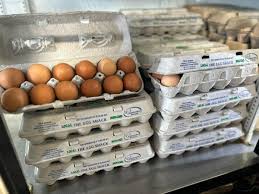LOUISVILLE, Ky. – Consumers across Kentucky are feeling the pinch of a sudden and sharp increase in egg prices, sparking concerns among households and businesses alike. The price hike, which began to take effect late last month, has left residents wondering about its root causes and when relief might come.
Egg Prices on the Rise
According to the U.S. Department of Agriculture (USDA), the average price for a dozen large eggs in Kentucky has surged by nearly 20% over the past four weeks. Retail prices now range between $3.50 and $4.00 per dozen, compared to around $2.80 earlier this year. For some rural areas, the prices have climbed even higher, with smaller grocery stores struggling to keep shelves stocked.
This increase comes on the heels of a broader national trend. The USDA notes that the United States has been grappling with elevated egg prices since 2022, largely driven by the aftereffects of the avian influenza outbreak, which resulted in the culling of millions of hens across the country. Kentucky, home to several large egg producers, was not spared from these losses.
“The bird flu epidemic drastically reduced our laying hen population,” explained Emily Carter, a poultry economist with the University of Kentucky Cooperative Extension Service. “Even though we’ve been rebuilding, it takes time for production to fully recover. When you combine this with other factors like rising feed costs and supply chain disruptions, it’s a perfect storm for price increases.”
Impact on Kentucky Families
The price surge has hit low-income households the hardest. Eggs, often seen as an affordable source of protein, are now becoming a luxury item for some families. Many are turning to food banks for assistance.
“We’ve seen a noticeable uptick in people coming in for egg donations,” said Mary Whitfield, director of operations at the Dare to Care Food Bank in Louisville. “Eggs are an essential staple for so many people, especially those with children. But even food banks are facing difficulties sourcing them at reasonable prices.”
Local eateries and bakeries are also feeling the pressure. Many small businesses, which rely heavily on eggs for menu items like breakfast platters, pastries, and desserts, are being forced to reconsider pricing or portion sizes.
“We’ve had to raise our prices by 10% across the board,” said Carlos Ramirez, owner of Sweet Sunrise Bakery in Lexington. “It’s either that or risk losing profits altogether. It’s frustrating because we know our customers are struggling too.”
What’s Driving the Spike?
While avian flu is the primary culprit, experts point to additional factors contributing to the ongoing price increases.
- Rising Feed Costs: The cost of feed for hens, primarily composed of corn and soybeans, has risen due to global supply chain challenges and the conflict in Ukraine.
- Transportation Issues: Higher fuel prices and labor shortages in the trucking industry have increased the cost of transporting eggs from farms to grocery stores.
- Demand Surge: As inflation forces many households to cut back on pricier proteins like beef and chicken, the demand for eggs has surged, further straining supply.
State officials are working to address these issues. The Kentucky Department of Agriculture is offering subsidies to local egg producers to help offset feed costs. Additionally, the USDA has launched programs to support poultry farmers nationwide, helping them rebuild their flocks and improve biosecurity measures.
Are There Alternatives?
For consumers seeking relief, experts recommend exploring alternative protein sources, such as beans, lentils, and tofu, which remain more stable in price. Another option is purchasing eggs in bulk from wholesale clubs or local farmers.
“Buying directly from farmers’ markets can be more affordable and ensures the money stays in the community,” said Sarah Jenkins, an agricultural consultant based in Louisville. “Plus, you’re likely to get fresher products.”
For those who frequently use eggs in baking, substitutes like applesauce, mashed bananas, or yogurt can provide a cost-effective alternative.
Outlook for Prices
While prices are expected to remain high in the short term, analysts believe relief could be on the horizon by mid-2025. As poultry farmers continue to expand their flocks and adopt better disease-prevention measures, the egg supply is expected to stabilize.
However, Carter warns that the industry remains vulnerable to future disruptions. “This isn’t the first time we’ve seen major price volatility due to avian flu, and it likely won’t be the last. It’s a reminder of the need for ongoing investment in disease prevention and supply chain resilience.”
What Can Consumers Do?
In the meantime, state agencies are encouraging consumers to stay informed and make smart purchasing decisions. The Kentucky Department of Agriculture’s Egg Price Tracker provides real-time updates on prices and availability, helping families budget more effectively.
Additionally, consumers can learn more about food assistance programs, such as the USDA’s Supplemental Nutrition Assistance Program (SNAP), which offers benefits to eligible low-income households.
Conclusion
For Kentucky residents, the sudden rise in egg prices is more than just an economic issue—it’s a stark reminder of the interconnectedness of global events, local agriculture, and household budgets. As families and businesses adjust to the new normal, they look toward state and federal efforts to stabilize the market and prevent future disruptions.
Until then, consumers are left scrambling to make ends meet—one egg at a time.
Disclaimer – Our team has carefully fact-checked this article to make sure it’s accurate and free from any misinformation. We’re dedicated to keeping our content honest and reliable for our readers.








